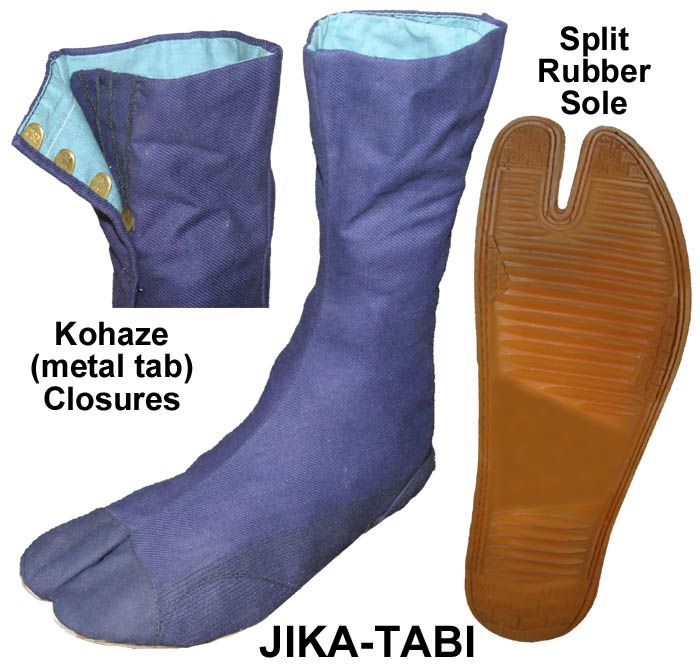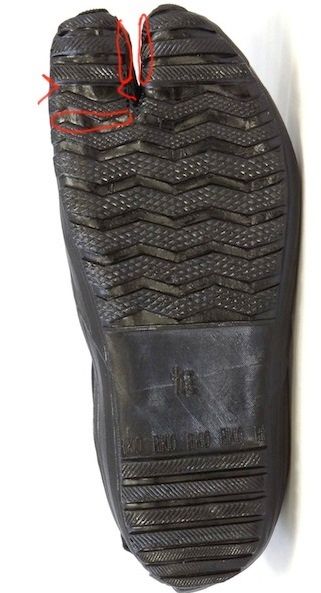At the risk of a necro, I have ordered a jikatabi (the Tokushei) and have worn it for a few days now. I'll list my experiences below.
But first:
I am considering using a file to modify the sole by removing small sections to improve it or doing something to soften the sole. Please write if you have any experience with either.
First, about sizing and Japanese shoe sizes: when you measure the distance from the middle of your heel to the tip of your longest toe (
as show here), keep in mind that this is your barefoot size. Jikatabis are meant to be worn barefoot. Putting on socks can give you 0.5-1cm depending on how thick socks you use. It is highly recommended to get seamless socks, the seamed tabis I ordered along were a tad uncomfortable. My size is roughly 26cm this way but with socks I can tell I should have gotten a 26.5 although I may be one of those people that need one size bigger shoes because how wide their feet are. The jikatabi I have is sized 27 (they didn't have 26.5 ones) and I can still fill it out comfortably although I have to push my toes in. I can fill it out also by adding an insole.
Second off, the thickness of the outsole and protection: it is at least as thick as thinner sport shoes. It is also dense rubber, denser and harder than my regular sport shoe (a Kalenji Ekiden 75). I actually tried to step on a standing pointer nail with it (while sitting) and it didn't let the nail trough. It got stuck into the rubber and it didn't allow to penetrate. I clearly felt that I was stepping into something trough the sole. However the sole was still flexible enough to allow me to roll the shoe up like a mattress. The rigidness of the sole seems to be lightening up a bit with use.
The Tukoshei is partially waterproof (I can stand in very shallow puddles without getting my feet wet) but there is still exposed canvas. I have sprayed impregnating spray on the non-rubberized canvas and this was a good decision when I came back having to brush mud off. Anything above the sole is canvas or rubberized canvas, although the Tukoshei does have rubber extending up to the front of the toe-boxes, which is good.
Sensation is also greater than a thicker (but softer-soled) shoes. In general the jikatabi appears to be a lighter version of sneakers and are an improvement on the advantages that lighter shoes have but also gives the disadvantages they bring. It is lighter, thinner and gives significantly more freedom of movement in the toes. This is good when you need to curl up your toes for correct running form (so as to not step on your toes). I can feel that I can bend my foot to a ball more in the jikatabi than in the sneakers.
My disappointment however was in the toe area. I have been doing exercises to treat my flat fleet and those include picking up things (a sock and a pen) with my toes, including a bigtoe-longtoe grip. With the jikatabis on I could barely move my toe and the only thing I could grip was a sheet of paper as that is the only thing I can slip in the toe-gap. Again, compared to regular shoes that restrict toe movement it was still better, but to my other two minimalist shoes I still found it restricting.
I believe the problem with the jikatabi is in the design of the sole. Simply put, it is a flat piece of rubber that cannot expand or contract. When I try to move my toes they are restricted by the fact the whole sole accommodate this by anything else but by moving the whole sole up and down the foot. When curl my toes up I am pulling the shoe-sole forward. When I curve my toes down I am creating an arch with the shoe-sole.
This is clearly a design flaw in jikatabis in general as I see similar soles on other jikatabis. Even on more expensive ones such as the
Assaboots ones that are sold in Europe.
Kage ones seem to have some minimal improvement by adding an X-shaped space but even that is at the ball, not at the toes where they need to be. I am certain that the many sneakers with the jikatabi-like big-toe pocket also suffer from this problem, though I admit I have not tried those.
The other problem with the jikatabis I feel is that it does not hold the ball of my foot. This is a peculiarity of jikatabi is that you have to push metal clasps (called kohaze) trough string loops. They grab hold of the forefoot well but do not adequately pull the ball section of the foot. I have two "settings" for the clasps. Which setting (which string loop I use) depends on how thick socks I am wearing. With thicker socks I can feel restricted bloodflow. Western-traditional shoe-strings would not help much because those tighten around the front of the boot not the rear. Still, when I lift and bend my foot even slightly forward, I feel as if the ball of my foot is hanging in the air. This may be due that I ordered a slightly too large sized shoe.
Another flaw, one I expected, is that there is no cushioning. There are jikatabi that have cushioning but these does and I can feel it. This is partially good for me because I want to feel when I am stepping too hard and I want to be reminded to switch to a lighter stepping style.
Overall, I have a pair of shoes that give me more freedom of movement and sensation than my sneakers or hiking boots but still give greater protection and rigidity than my more minimalist shoes. I have walked on slippery mud on them and they are good there.
However I am not satisfied with them as-is. I want to modify them by using a file and remove material from the sole. I want to create gaps in-between sports where I move my toes. I want to remove material so to move my toes I don't have to bend the entire sole. I also want to remove excess bits from around the toe area to better allow slipping things in-between the big-toe and long-toe.
I have no idea what effect this would have on the sole as a whole. Would this crack the sole? Would any hole or damage spread? Or would it behave like rigid plastic and the gaps wouldn't cause structural problems. All I can find is that the sole is made out of JRFMA (Japan Rubber Footwear Manufacturers Association) rubber sole.
I am also considering whether softening the sole would help. From what google has thrown at me, this can be done to vulcanized rubber by having it suck in plasticizers.


